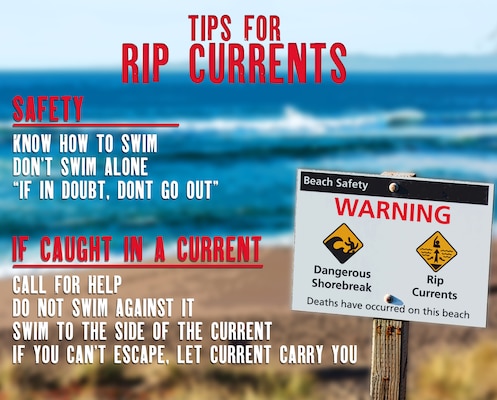 The National Oceanic and Administration Association describes rip currents as powerful, narrow channels of fast-moving water that are prevalent along the East, Gulf, and West coasts of the United States, as well as along the shores of the Great Lakes. In some cases, rip currents have been measured as fast as 8 feet per second, pulling even the strongest swimmers out from shore. Rip currents can be as narrow as 10 or 20 feet in width, though some may be up to 10 times wider. The length of the rip current also varies. Rip currents begin to slow down as they move offshore, beyond the breaking waves, but sometimes extend for hundreds of feet beyond the surf zone.
The National Oceanic and Administration Association describes rip currents as powerful, narrow channels of fast-moving water that are prevalent along the East, Gulf, and West coasts of the United States, as well as along the shores of the Great Lakes. In some cases, rip currents have been measured as fast as 8 feet per second, pulling even the strongest swimmers out from shore. Rip currents can be as narrow as 10 or 20 feet in width, though some may be up to 10 times wider. The length of the rip current also varies. Rip currents begin to slow down as they move offshore, beyond the breaking waves, but sometimes extend for hundreds of feet beyond the surf zone.When looking for rip currents, some visual clues include a narrow gap of darker, seemingly calmer water between areas of breaking waves and whitewater; a channel of churning, choppy water; a difference in the water’s color and a line of foam and seaweed or debris moving seaward.
What to do if caught in a rip current:
· Relax, rip currents don’t pull you under.
· Don’t swim against the current.
· You may be able to escape by swimming out of the current in a direction following the shoreline or toward breaking waves, then at an angle toward the beach.
· You may be able to escape by floating or treading water if the current circulates back toward shore.
· If you feel you can’t reach shore, draw attention to yourself. If you need help, yell and wave for assistance.
What should you do if you see someone caught in a rip current? Do not get caught in a rip current trying to save someone else. Throw them a flotation device, get help from the Beach Patrol and call emergency services. Do not attempt a swimming rescue unless you have been trained to rescue a person in the water, are a strong swimmer and have flotation for the victim to hang on to when you reach them.
Well, what about rip tides? Are they the same? Not to be confused with rip currents are rip tides. While the terms are often confused, rip currents differ from rip tides. A rip tide is a specific type of current associated with the swift movement of tidal water through inlets and the mouths of estuaries, embayments and harbors. Like rip currents, one must remain vigilant and practice good risk management in these locations.
Don’t become a statistic. To help you and those around you stay safe and manage risk, stay aware of the weather, the ocean, the tide and what is happening around you. Inclement weather, such as thunderstorms, tropical storms and hurricanes far out at sea, can create dangerous waves and currents at the beach, even on a sunny day.
In the United States, you can visit NWS Offices Issuing Surf Zone Forecasts (weather.gov) to see the latest water conditions before you head to the beach.
For more information on rip currents and riptides, you can visit What is a rip current? (noaa.gov)
